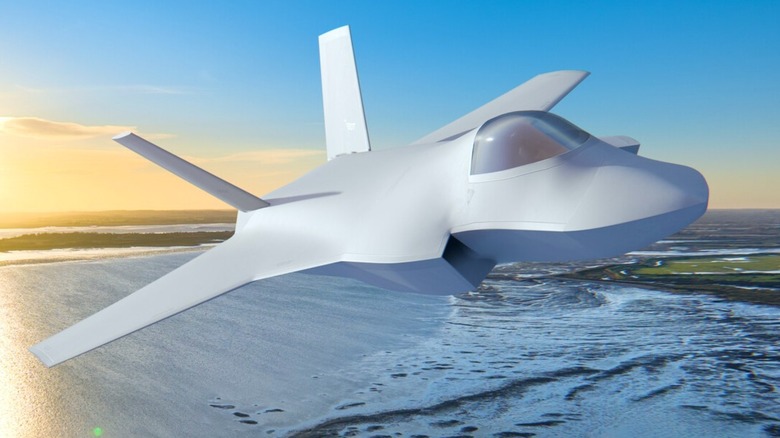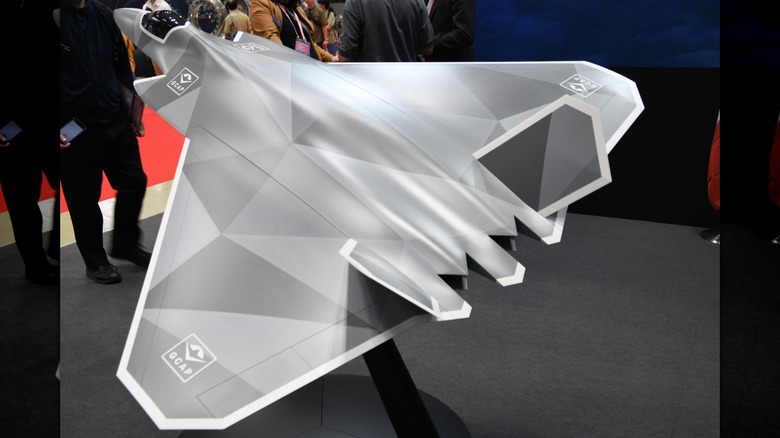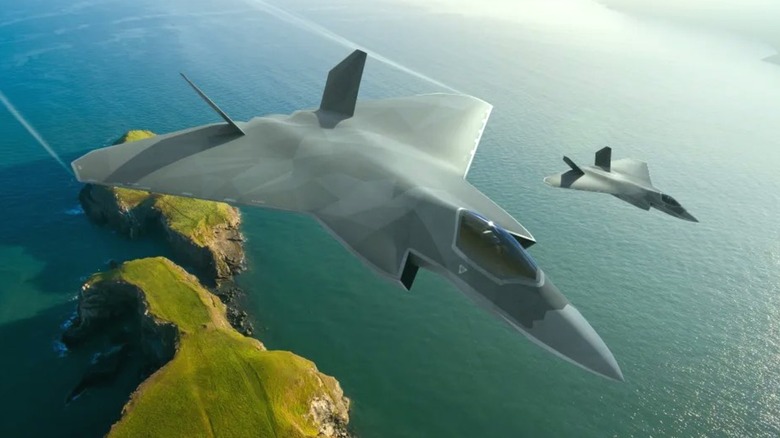
While the United States led the way in developing fifth-generation jet fighters with the introduction of the F-22 Raptor in 2005, it's hardly the only nation working on next-gen aircraft. China, Russia, and many European nations are eying cutting-edge technology for their fighters, and one of the most promising in development is the ongoing Global Combat Air Programme (GCAP), also known as Tempest, led by the United Kingdom. The aim is to create a sixth-generation fighter that outclasses the U.K.-spec
F-35B, the Eurofighter Typhoon, and Japan's Mitsubishi F-2.
Some renderings and models of what it might look like popped up online when the project was announced in 2018. However, it wasn't until BAE Systems Air posted a confirmed image of the demonstrator aircraft's design on X in July 2025 that military watchers got their first official glimpse. To be clear, the fully assembled aircraft is still out of reach, as the post indicates that two-thirds of the structural weight of the demonstrator was in the manufacturing stage. Still, the image and the fact that its structure is around 66% complete suggest it won't be too long before a final aircraft is unveiled.
The fighter's design bears a striking resemblance to the F-35 in its tail, canopy, and nose cone. Granted, this is just an artist's rendering of what it should look like. Changes to the design are likely to happen as testing and overcoming unforeseen issues tend to impact aircraft development. The final form won't be revealed for some time, as the collaborative effort, which includes Italy, Japan, and the U.K., is looking to field the fighter by 2035.
Read more: 11 Of The Most Iconic Ground Attack Military Planes In History
The GCAP Tempest Program

The Tempest program represents the first piloted supersonic aircraft the U.K. has developed in 40 years. While international partners are involved, in the U.K., the Ministry of Defense, BAE Systems Air, Leonardo, MBDA UK, and Rolls-Royce are all working together to produce the demonstrator Tempest aircraft. Once planning began, the goal was to produce the demonstrator within five years, and it appears they're on schedule. The Combat Air Flying Demonstrator is an important first step in testing and reconfiguring designs for the production of a final jet fighter.
Test pilots have already flown over 300 hours in a specially designed flight simulator, and using the data acquired from these sessions, engineers and designers can assess the flight control systems during complex aerial maneuvers. The demonstrator will reduce the time needed to finalize the design, and is an important milestone in the development of the GCAP Tempest program. Once complete, the Royal Air Force will field one of the most advanced 6th-generation fighter jets in the world.
The next step in the GCAP, once the Tempest demonstrator aircraft is fully assembled and made flightworthy, is to put it through its paces. The idea of a demonstrator is to test new technologies, the overall aerodynamics, the propulsion system, the material that makes up the plane's structure, and more. Wherever any shortfalls are detected, engineers will address these issues and make changes, pushing towards the final design, so a demonstrator is an important next step in the development of the Tempest fighter jet.
The Tempest Fighter

There's not a great deal of detail about the Tempest's projected capabilities, but the stated desire of outclassing the most advanced fighter jet of all time, the F-35, suggests some lofty goals. Costs aren't fully known either, though the Ministry of Defense budgeted over £12 billion ($15.9 billion) for the next ten years for GCAP. Rolls-Royce is developing a bespoke engine, of which the Tempest will have two. These will optimize installation, thermal management, and integrated power management.
The plan is to produce a fighter with twice the payload of the F-35 with an extreme range that would enable the fighter to fly across the Atlantic Ocean on internal fuel tanks. The internal components and electronics are also in development, with the Multi-Function Radio Frequency System being designed by Leonardo in Italy. BAE has touted the fighter's potential for reconfigurability, advanced power and propulsion, affordability, advanced digital processing, a virtual cockpit, flexible payload configurations, and upgradability.
In terms of payload, the F-35 can carry 18,000 lbs., but it's probable that the claim of doubling its capacity refers to the fighter's internal payload, which is 10,000 lbs. It's unclear how carrying 20,000 lbs. of internal ordnance will impact fuel capacity and range, but that appears to be the plan for Tempest. Whatever is packed inside, it will likely be new, as the plan is to fit the Tempest with ultra-long-range air-to-air missiles that are being developed with it in mind. Additionally, the Tempest will be a stealth aircraft and will feature what is described as a "flying server rack" meant to function alongside complementary autonomous drones.
Want the latest in tech and auto trends? Subscribe to our free newsletter for the latest headlines, expert guides, and how-to tips, one email at a time.
Read the original article on SlashGear.












